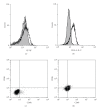Immune reactions against elongation factor 2 kinase: specific pathogenesis of gastric ulcer from Helicobacter pylori infection
- PMID: 19636416
- PMCID: PMC2712636
- DOI: 10.1155/2009/850623
Immune reactions against elongation factor 2 kinase: specific pathogenesis of gastric ulcer from Helicobacter pylori infection
Abstract
Helicobacter pylori (H. pylori) infection is a definite causative factor for gastric ulcers (GUs). In the present study we detected a specific antigen of gastric epithelial cells (HGC-27) using cell ELISA, which was recognized by the sera of GU patients (n = 20) but not in patients with chronic gastritis (CG; n = 20) or in healthy volunteers (HC; n = 10). This antigen was over-expressed by a stressful (heat-stressed) environment, and was identified as elongation factor 2 kinase (EF-2K) by western blotting. The GU patients' lymphocytes stimulated by H. pylori specifically disrupted heat-stressed HGC-27 cells in a cytotoxic assay. In flow cytometry, the effector cells (lymphocytes) from GU patients were significantly differentiated to T helper type 1 lymphocyte (Th1) and cytotoxic T lymphocyte (CTL) as opposed to those from CG patients. The target cells (HGC-27) expressed EF-2K and MHC-class I together with costimulatory molecules from heat stress. This antigen specific immune mechanism could have a prominent role in the pathogenesis of GU.
Figures





Similar articles
-
Association of the CagA gene positive Helicobacter pylori and tissue levels of interleukin-17 and interleukin-8 in gastric ulcer patients.Egypt J Immunol. 2012;19(1):51-62. Egypt J Immunol. 2012. PMID: 23888551
-
Recruitment of CCR6+ Foxp3+ regulatory gastric infiltrating lymphocytes in Helicobacter pylori gastritis.Helicobacter. 2019 Feb;24(1):e12550. doi: 10.1111/hel.12550. Epub 2018 Nov 9. Helicobacter. 2019. PMID: 30412323
-
Correlation between CD4, CD8 cell infiltration in gastric mucosa, Helicobacter pylori infection and symptoms in patients with chronic gastritis.World J Gastroenterol. 2005 Apr 28;11(16):2486-90. doi: 10.3748/wjg.v11.i16.2486. World J Gastroenterol. 2005. PMID: 15832423 Free PMC article.
-
Helicobacter pylori antigen-specific T-cell responses at gastric level in chronic gastritis, peptic ulcer, gastric cancer and low-grade mucosa-associated lymphoid tissue (MALT) lymphoma.Microbes Infect. 2003 Jul;5(8):723-30. doi: 10.1016/s1286-4579(03)00114-x. Microbes Infect. 2003. PMID: 12814773 Review.
-
The role of T helper 1-cell response in Helicobacter pylori-infection.Microb Pathog. 2018 Oct;123:1-8. doi: 10.1016/j.micpath.2018.06.033. Epub 2018 Jun 21. Microb Pathog. 2018. PMID: 29936093 Review.
Cited by
-
1-Deoxynojirimycin (DNJ) Ameliorates Indomethacin-Induced Gastric Ulcer in Mice by Affecting NF-kappaB Signaling Pathway.Front Pharmacol. 2018 Apr 19;9:372. doi: 10.3389/fphar.2018.00372. eCollection 2018. Front Pharmacol. 2018. PMID: 29725297 Free PMC article.
References
-
- Marshall BJ, Armstrong JA, McGechie DB, Glancy RJ. Attempt to fulfil Koch's postulates for pyloric campylobacter. Medical Journal of Australia. 1985;142(8):436–439. - PubMed
-
- Marshall BJ, McGechie DB, Rogers PA, Glancy RJ. Pyloric campylobacter infection and gastroduodenal disease. The Medical Journal of Australia. 1985;142(8):439–444. - PubMed
-
- Graham DY, Lew GM, Klein PD, et al. Effect of treatment of Helicobacter pylori infection on the long-term recurrence of gastric or duodenal ulcer. A randomized, controlled study. Annals of Internal Medicine. 1992;116(9):705–708. - PubMed
-
- Parsonnet J, Friedman GD, Vandersteen DP, et al. Helicobacter pylori infection and the risk of gastric carcinoma. The New England Journal of Medicine. 1991;325(16):1127–1131. - PubMed
Publication types
MeSH terms
Substances
LinkOut - more resources
Full Text Sources
Medical
Research Materials

